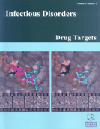- Home
- A-Z Publications
- Infectious Disorders - Drug Targets (Formerly Current Drug Targets - Infectious Disorders)
- Previous Issues
- Volume 12, Issue 3, 2012
Infectious Disorders - Drug Targets (Formerly Current Drug Targets - Infectious Disorders) - Volume 12, Issue 3, 2012
Volume 12, Issue 3, 2012
-
-
Editorial [Hot Topic: B Lymphocytes as Programmers and Effectors of Immunity, their Roles Beyond Antibody Production (Guest Editor: Simon Fillatreau)]
More LessB lymphocytes provide essential protection against infections, and also act as drivers of pathogenesis in some autoimmune diseases. During the recent years, major progress has been made in our understanding of the molecular mechanisms controlling B cell activation, and several novel functions of B cells independent of antibody production have been discovered. The aim of this volume is to present some of these novel Read More
-
-
-
Role of Inhibitory BCR Co-Receptors in Immunity
More LessB lymphocytes (B cells) express a variety of membrane molecules containing immunoreceptor tyrosine-based inhibition motifs (ITIMs) in the cytoplasmic region such as FcγRIIB, FCRLs, CD22, mouse Siglec-G/human Siglec-10, PECAM-1, mouse PIR-B/human LIRB1 and LIRB2PD-1 and CD72. When phosphorylated, ITIMs in these molecules recruit and activate phosphatases such as SH2 domain-containing protein tyrosine phos Read More
-
-
-
Functional Interactions Between B Lymphocytes and the Innate Immune System
More LessAuthors: Vicky Lampropoulou, Ping Shen, Ellen Hilgenberg, Stefanie Ries, Christian Opitz and Simon FillatreauThe immune system is composed of multiple cell types, which together improve the resistance of the organism against infections. The unfolding of a successful host response ensuring effective protection against pathogens requires an appropriate coordination of the different players of the immune system. Innate cells and T cells extensively communicate during immune reactions, providing multiple opportunities for the mut Read More
-
-
-
Evolutionary and Functional Relationships of B Cells from Fish and Mammals: Insights into their Novel Roles in Phagocytosis and Presentation of Particulate Antigen
More LessThe evolutionary origins of Ig-producing B cells appear to be linked to the emergence of fish in this planet. There are three major classes of living fish species, which from most primitive to modern they are referred to as agnathan (e.g., lampreys), Chondrichthyes (e.g., sharks), and teleost fish (e.g., rainbow trout). Agnathans do not have immunoglobulin- producing B cells, however these fish contain a subset of lymphocytes-like Read More
-
-
-
Unraveling Effector Functions of B Cells During Infection: The Hidden World Beyond Antibody Production
More LessAntibodies made by B cells are critically important for immune protection to a variety of infectious agents. However, it is becoming increasingly clear that B cells do more than make antibodies and that B cells can both enhance and suppress immune responses. Furthermore, there is growing evidence that B cells modulate cellular immune responses by antibody dependent and independent mechanisms. Although we have a g Read More
-
-
-
B Cells: Programmers of CD4 T Cell Responses
More LessAuthors: Tom A. Barr, Mohini Gray and David GrayB cells are once again gaining prominence as important programmers of CD4 T cell responses. With widespread use of B cell depletion therapy in the clinic, proving effective in treating diseases previously considered T cellmediated, the time is right for a re-appraisal of the B cell. Though typically considered weak, Th2 driving APC, it is now clear that they are necessary for a robust and long-lived CD4 T cell response in ma Read More
-
-
-
Primary and Secondary B-Cell Responses to Pulmonary Virus Infection
More LessAuthors: Yoshimasa Takahashi, Taishi Onodera, Kazuo Kobayashi and Tomohiro KurosakiViruses form particulate structures possessing high-density B-cell epitopes and viral RNA/DNA, which are ligands for multiple Toll-like receptors (TLRs). B cells are able to sense these viral antigenic signatures through B-cell antigen receptors (BCRs) and TLRs, both of which synergistically shape the magnitude and quality of virus-specific B-cell responses. In many viruses, B-cell recognition of these virus signatures is often h Read More
-
-
-
B-Cell Based Gene Therapy for Autoimmune Diseases
More LessAuthors: David W. Scott, Ai-Hong Zhang and Yan SuThe essence of the adaptive immune system is self tolerance, which is maintained by various central and peripheral check points. However, the tolerance mechanisms can be broken in autoimmune disease conditions due to genetic predisposition and environmental triggers. As a consequence, a patient’s tissue is attacked by his/her own adaptive immune system. An ideal therapy for autoimmune diseases should i Read More
-
-
-
Reprogramming of B Cells into Regulatory Cells with Engineered Fusokines
More LessAuthors: Jiusheng Deng and Jacques GalipeauB cells play a pivotal role in host adaptive immunity against pathogenic microorganisms, but may also maladaptively contribute to the pathogenesis of autoimmune diseases. In contrast, distinct B cell subsets have the capacity to regulate host immune response, and suppress inflammation. B regulatory cells are a rare population of endogenous Blymphocytes defined in part by production of the anti-inflammatory cytokine IL-1 Read More
-
Volumes & issues
-
Volume 25 (2025)
-
Volume 24 (2024)
-
Volume 23 (2023)
-
Volume 22 (2022)
-
Volume 21 (2021)
-
Volume 20 (2020)
-
Volume 19 (2019)
-
Volume 18 (2018)
-
Volume 17 (2017)
-
Volume 16 (2016)
-
Volume 15 (2015)
-
Volume 14 (2014)
-
Volume 13 (2013)
-
Volume 12 (2012)
-
Volume 11 (2011)
-
Volume 10 (2010)
-
Volume 9 (2009)
-
Volume 8 (2008)
-
Volume 7 (2007)
-
Volume 6 (2006)
Most Read This Month
Article
content/journals/iddt
Journal
10
5
false
en


